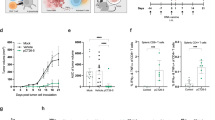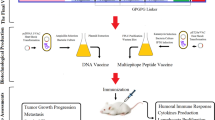Abstract
Active immunotherapy of cancer has yet to yield effective therapies in the clinic. To evaluate the translatability of DNA-based vaccines we analyzed the profile of T-cell immunity by plasmid vaccination in a murine model, using transcriptome microarray analysis and flow cytometry. DNA vaccination resulted in specific T cells expressing low levels of co-inhibitory molecules (most notably PD-1), strikingly different from the expression profile elicited by peptide immunization. In addition, the T-cell response primed through this dual-antigen-expressing plasmid (MART-1/Melan-A and tyrosinase) translated into a substantial proliferation capacity and functional conversion to antitumor effector cells after tyrosinase and MART-1/Melan-A peptide analog boost. Furthermore, peptide boost rescued the immune response against the subdominant tyrosinase epitope. This immunization approach could be adapted to elicit potent immunity against multiple tumor antigens, resulting in a broader immune response that was more effective in targeting human tumor cells. Finally, this study sheds light on a novel mechanism of immune homeostasis through synchronous regulation of co-inhibitory molecules on T cells, highly relevant to heterologous prime boost approaches involving DNA vaccines as priming agents.
This is a preview of subscription content, access via your institution
Access options
Subscribe to this journal
Receive 12 print issues and online access
$259.00 per year
only $21.58 per issue
Buy this article
- Purchase on SpringerLink
- Instant access to full article PDF
Prices may be subject to local taxes which are calculated during checkout







Similar content being viewed by others
References
Fecher LA, Flaherty KT . Where are we with adjuvant therapy of stage III and IV melanoma in 2009? J Natl Compr Canc Netw 2009; 7: 295–304.
Sullivan RJ, Atkins MB . Molecular-targeted therapy in malignant melanoma. Expert Rev Anticancer Ther 2009; 9: 567–581.
Cerottini JC, von Fliedner V, Boon T . Ann. Recognition of tumor-associated antigens by T lymphocytes: from basic concepts to new approaches. Oncology 1992; 3: 11–16.
Van Der Bruggen P, Zhang Y, Chaux P, Stroobant V, Panichelli C, Schultz ES et al. Tumor-specific shared antigenic peptides recognized by human T cells. Immunol Rev 2002; 188: 51–64.
Kawakami Y, Robbins PF, Wang RF, Parkhurst M, Kang X, Rosenberg SA . The use of melanosomal proteins in the immunotherapy of melanoma. J Immunother 1998; 21: 237–246.
Goodwin DP, Hornung MO, Krementz ET . Extraction and use of melanoma-associated protein for immunotherapy. Oncology 1973; 27: 258–265.
Kawakami Y, Eliyahu S, Sakaguchi K, Robbins PF, Rivoltini L, Yannelli JR et al. Identification of the immunodominant peptides of the MART-1 human melanoma antigen recognized by the majority of HLA-A2-restricted tumor infiltrating lymphocytes. J Exp Med 1994; 180: 347–352.
Brichard V, Van Pel A, Wölfel T, Wölfel C, De Plaen E, Lethé B et al. The tyrosinase gene codes for an antigen recognized by autologous cytolytic T lymphocytes on HLA-A2 melanomas. J Exp Med 1993; 178: 489–495.
Robbins PF, Dudley ME, Wunderlich J, El-Gamil M, Li YF, Zhou J et al. Cutting edge: persistence of transferred lymphocyte clonotypes correlates with cancer regression in patients receiving cell transfer therapy. J Immunol 2004; 173: 7125–7130.
Rosenberg SA, Dudley ME . Adoptive cell therapy for the treatment of patients with metastatic melanoma. Curr Opin Immunol 2009; 21: 233–240.
Rosenberg SA, Yang JC, Restifo NP . Cancer immunotherapy: moving beyond current vaccines. Nat Med 2004; 10: 909–915.
Speiser DE, Liénard D, Rufer N, Rubio-Godoy V, Rimoldi D, Lejeune F et al. Rapid and strong human CD8+ T cell responses to vaccination with peptide, IFA, and CpG oligodeoxynucleotide 7909. Clin Invest 2005; 115: 739–746.
Jäger E, Chen YT, Drijfhout JW, Karbach J, Ringhoffer M, Jäger D et al. Simultaneous humoral and cellular immune response against cancer-testis antigen NY-ESO-1: definition of human histocompatibility leukocyte antigen (HLA)-A2-binding peptide epitopes. J Exp Med 1998; 187: 265–270.
Chen YT, Scanlan MJ, Sahin U, Türeci O, Gure AO, Tsang S et al. A testicular antigen aberrantly expressed in human cancers detected by autologous antibody screening. Proc Natl Acad Sci USA 1997; 94: 1914–1918.
Ayyoub M, Stevanovic S, Sahin U, Guillaume P, Servis C, Rimoldi D et al. Proteasome-assisted identification of a SSX-2-derived epitope recognized by tumor-reactive CTL infiltrating metastatic melanoma. J Immunol 2002; 168: 1717–1722.
Silk AW, Finn OJ . Cancer vaccines: a promising cancer therapy against all odds. Future Oncol 2007; 3: 299–306.
Atkins MB, Lotze MT, Dutcher JP, Fisher RI, Weiss G, Margolin K et al. High-dose recombinant interleukin 2 therapy for patients with metastatic melanoma: analysis of 270 patients treated between 1985 and 1993. J Clin Oncol 1999; 17: 2105–2116.
Sarnaik AA, Weber JS . Recent advances using anti-CTLA-4 for the treatment of melanoma. Cancer J 2009; 15: 169–173.
Ribas A . Overcoming immunologic tolerance to melanoma: targeting CTLA-4 with tremelimumab (CP-675,206). Oncologist 2008; 13: 10–15.
Weber J, Boswell W, Smith J, Hersh E, Snively J, Diaz M et al. Phase 1 trial of intranodal injection of a Melan-A/MART-1 DNA plasmid vaccine in patients with stage IV melanoma. J Immunother 2008; 31: 215–223.
Tagawa ST, Lee P, Snively J, Boswell W, Ounpraseuth S, Lee S et al. Phase I study of intranodal delivery of a plasmid DNA vaccine for patients with Stage IV melanoma. Cancer 2003; 98: 144–154.
Maloy KJ, Erdmann I, Basch V, Sierro S, Kramps TA, Zinkernagel RM et al. Intralymphatic immunization enhances DNA vaccination. Proc Natl Acad Sci USA 2001; 98: 3299–3303.
Klebanoff CA, Gattinoni L, Torabi-Parizi P, Kerstann K, Cardones AR, Finkelstein SE et al. Central memory self/tumor-reactive CD8+ T cells confer superior antitumor immunity compared with effector memory T cells. Proc Natl Acad Sci USA 2005; 102: 9571–9576.
Hinrichs CS, Borman ZA, Cassard L, Gattinoni L, Spolski R, Yu Z et al. Adoptively transferred effector cells derived from naive rather than central memory CD8+ T cells mediate superior antitumor immunity. Proc Natl Acad Sci USA 2009; 106: 17469–17474.
Giri M, Ugen KE, Weiner DB . DNA vaccines against human immunodeficiency virus type 1 in the past decade. Clin Microbiol Rev 2004; 17: 370–389.
Rice J, Ottensmeier CH, Stevenson FK . DNA vaccines: precision tools for activating effective immunity against cancer. Nat Rev Cancer 2008; 8: 108–120.
Smith KA, Tam VL, Wong RM, Pagarigan RR, Meisenburg BL, Joea DK et al. Enhancing DNA vaccination by sequential injection of lymph nodes with plasmid vectors and peptides. Vaccine 2009; 27: 2603–2615.
Rivoltini L, Kawakami Y, Sakaguchi K, Southwood S, Sette A, Robbins PF et al. Induction of tumor-reactive CTL from peripheral blood and tumor-infiltrating lymphocytes of melanoma patients by in vitro stimulation with an immunodominant peptide of the human melanoma antigen MART-1. J Immunol 1995; 154: 2257–2265.
Pascolo S, Bervas N, Ure J, Smith AJ, Lemonnier FA, Perarnau B . HLA A2.1-restricted education and cytolytic activity of CD8+ T lymphocytes from β2 microglobulin HLA A2.1 monochain transgenic H-2 Db β2 m double knockout mice. J Exp Med 1997; 185: 2043–2051.
Smith KA, Meisenburg BL, Tam VL, Pagarigan RR, Wong R, Joea DK et al. Lymph node-targeted immunotherapy mediates potent immunity resulting in regression of isolated or metastatic human papillomavirus-transformed tumors. Clin Cancer Res 2009; 15: 6167–6176.
Liu J, Hamrouni A, Wolowiec D, Coiteux V, Kuliczkowski K, Hetuin D et al. Plasma cells from multiple myeloma patients express B7-H1 (PD-L1) and increase expression after stimulation with IFN-γ and TLR ligands via a MyD88-, TRAF6-, and MEK-dependent pathway. Blood 2007; 110: 296–304.
Huang B, Zhao J, Li H, He K-L, Chen Y, Mayer L et al. Toll-like receptors on tumor cells facilitate evasion of immune surveillance. Cancer Res 2005; 65: 5009–5014.
Wong RM, Smith KA, Tam VL, Pagarigan RR, Meisenburg BL, Quach AM et al. TLR-9 signaling and TCR stimulation co-regulate CD8+ T cell-associated PD-1 expression. Immunol Lett 2009; 127: 60–67.
Fife BT, Bluestone JA . Control of peripheral T-cell tolerance and autoimmunity via the CTLA-4 and PD-1 pathways. Immunol Rev 2008; 224: 166–182.
Ha SJ, West EE, Araki K, Smith KA, Ahmed R . Manipulating both the inhibitory and stimulatory immune system towards the success of therapeutic vaccination against chronic viral infections. Immunol Rev 2008; 223: 317–333.
Keir ME, Butte MJ, Freeman GJ, Sharpe AH . PD-1 and its ligands in tolerance and immunity. Annu Rev Immunol 2008; 26: 677–704.
Acknowledgements
We thank David Diamond and Tessa L Roper for editorial review of the manuscript.
Author information
Authors and Affiliations
Corresponding author
Ethics declarations
Competing interests
K Smith receives compensation as a consultant for Mannkind Corporation. K Smith, Z Qiu, R Wong, V Tam, B Meisenburg, D Joea, A Quach, X Liu, M Pold, U Malyankar and A Bot were employees of Mannkind Corporation while the study was conducted.
Additional information
Supplementary Information accompanies the paper on Cancer Gene Therapy website
Rights and permissions
About this article
Cite this article
Smith, K., Qiu, Z., Wong, R. et al. Multivalent immunity targeting tumor-associated antigens by intra-lymph node DNA-prime, peptide-boost vaccination. Cancer Gene Ther 18, 63–76 (2011). https://doi.org/10.1038/cgt.2010.45
Received:
Revised:
Accepted:
Published:
Issue date:
DOI: https://doi.org/10.1038/cgt.2010.45
Keywords
This article is cited by
-
Splice-Correction Strategies for Treatment of X-Linked Agammaglobulinemia
Current Allergy and Asthma Reports (2015)
-
Novel and enhanced anti-melanoma DNA vaccine targeting the tyrosinase protein inhibits myeloid-derived suppressor cells and tumor growth in a syngeneic prophylactic and therapeutic murine model
Cancer Gene Therapy (2014)
-
The impact of intraoperative vaccination with IL-12 modified autologous tumor cells in the Lewis lung carcinoma mouse model
Journal of Cancer Research and Clinical Oncology (2012)



